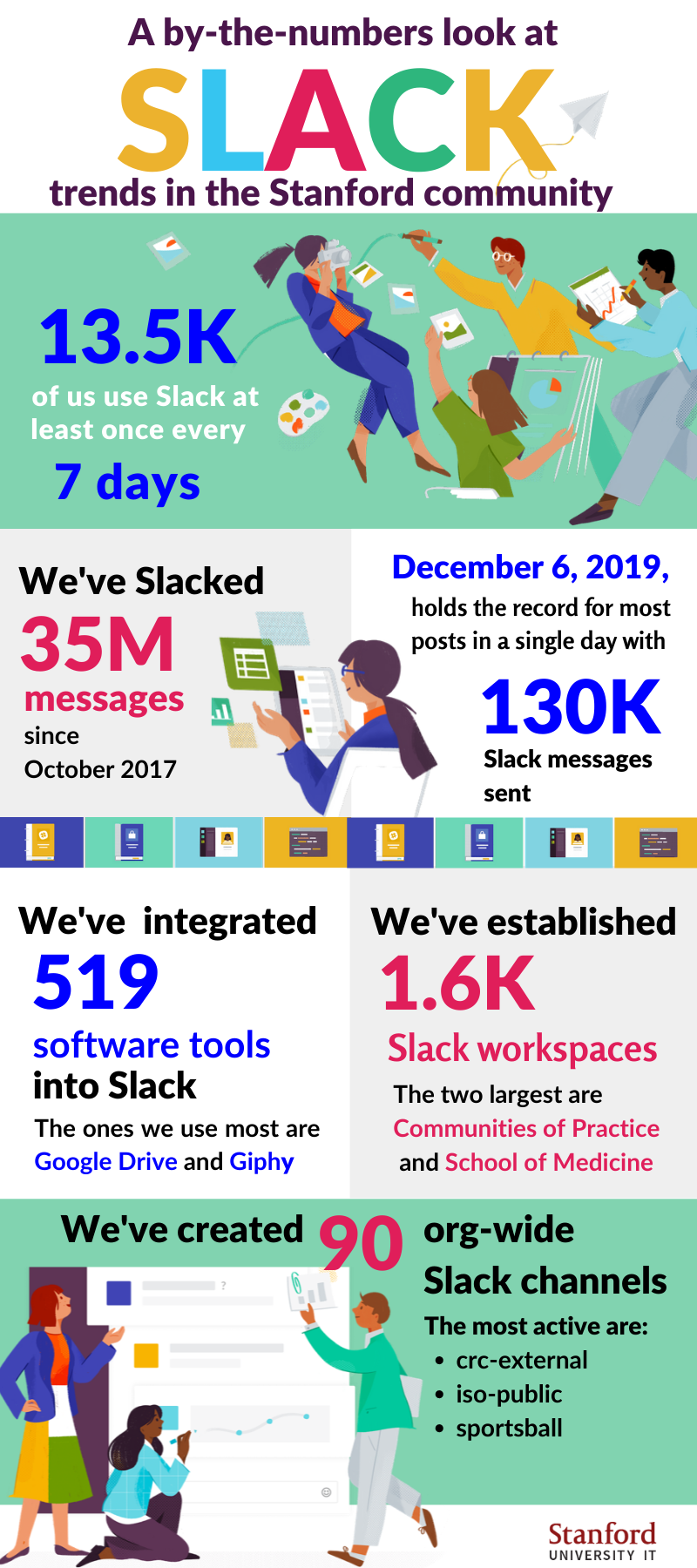
A by the numbers look at Slack trends in the Stanford community
13.5K of us use Slack at least once every 7 days.
We've slacked 35M messages since October 2017.
December 6, 2019, holds the record for the most posts in a single day with 130K Slack messages sent.
We've integrated 519 software tools into Slack.
The ones we use most are Google Drive and Giphy.
We've established 1.6K Slack workspaces.
The two largest are Communities of Practice and School of Medicine.
We've created 90 org-wide Slack channels.
The most active are: crc-external, iso-public, sportsball.
Stanford Slack recently marked its official second anniversary. And there’s a lot to celebrate. Two years into the journey, the platform has grown exponentially in ways we never anticipated. Today, more than 13,500 members of the Stanford community use Slack weekly. Of those users, almost three-quarters use the tool every day. Cumulatively, we now measure the messages we’ve sent and the files we’ve shared via Slack not in millions, but tens of millions. Amazing, isn’t it?
How Slack became part of our work life
To help keep the momentum going, we have a few new and exciting initiatives planned for 2020. I’ll talk about one of those later in this blog post. But before we look ahead, let’s review how Slack became a preferred collaboration tool.
A member of the Stanford community created our first Slack workspace at Stanford on Valentine’s Day 2014, so it’s true that Stanford had some early Slack “pioneers.” Over time, the love we felt for Slack spread, and hundreds more of us organically gravitated to the tool.
By October 2017, members of the Stanford community had established 600 workspaces. Individual teams or departments paid for separate Slack accounts or opted to use a free version with limited functionality. But the problem was, people could only send messages to colleagues who were in the same workspace.
When Slack introduced its Enterprise Grid product, we jumped on board - and the Stanford Slack grid was born. With that, our community could create an unlimited number of workspaces and shared channels. And we could find each other in Slack, to connect with one person or many, to make communicating across the Stanford community a snap.
Introducing the Slack blog
What’s next? We’ve accumulated a plethora of internal knowledge, and it makes sense that we learn from each other. So we’ve invited Stanford’s Slack enthusiasts to share tips and experiences in this new Slack blog on the University IT website.
You’ll get to hear first-hand how teams across Stanford use Slack to become more streamlined and engaged. We’ve already identified some power users to kick off the blog series, but we’ll look for new authors and ideas down the road. If Slack — and blogging — are your thing, we encourage you to contribute. Stay tuned for more information.
Stanford Slack Grid: A success story
When it comes to optimizing Slack use at Stanford, I look forward to what lies ahead. But I’m also impressed by what we’ve done so far. As we kick-off year three for the Stanford Slack Grid, please join me in celebrating the success of Slack, as told by these numbers.



